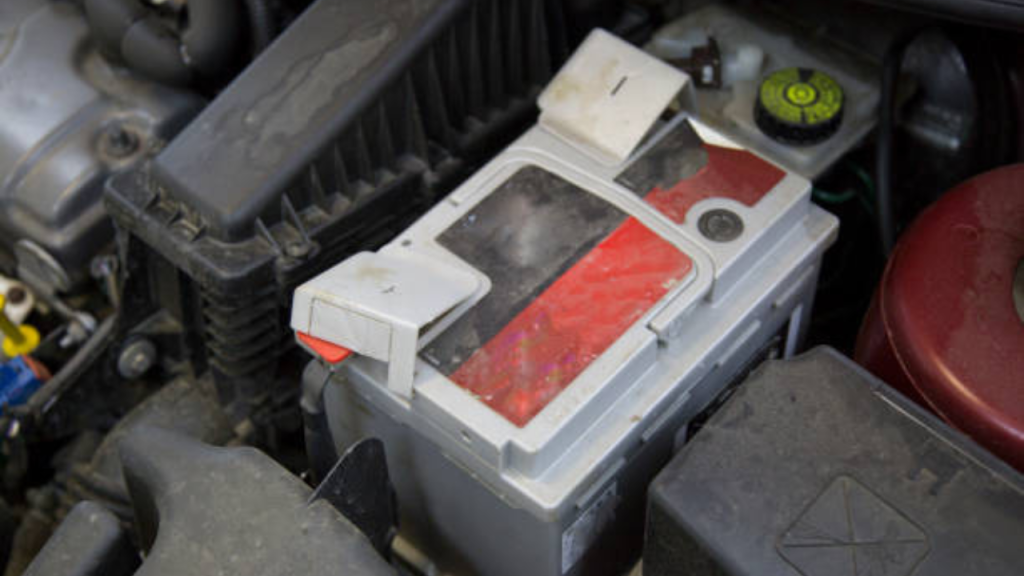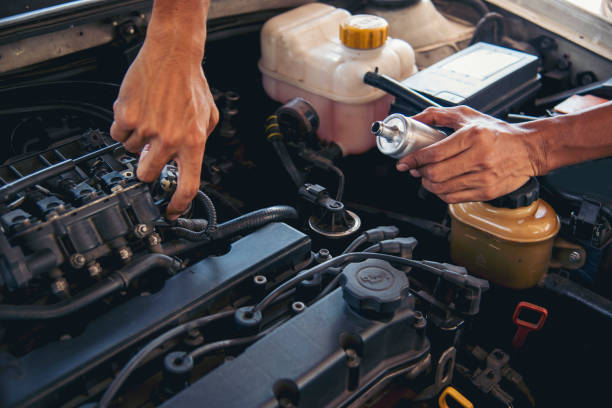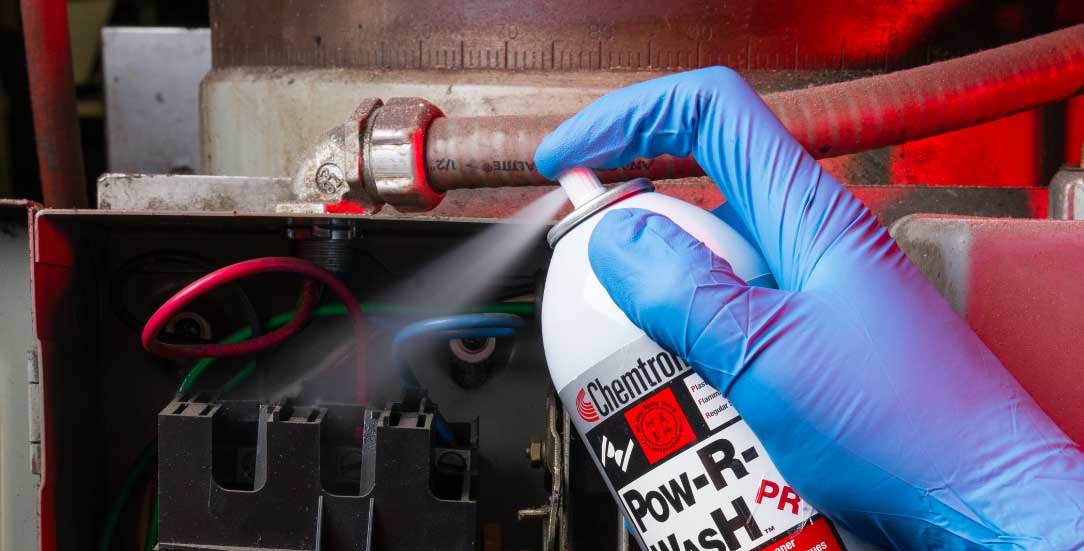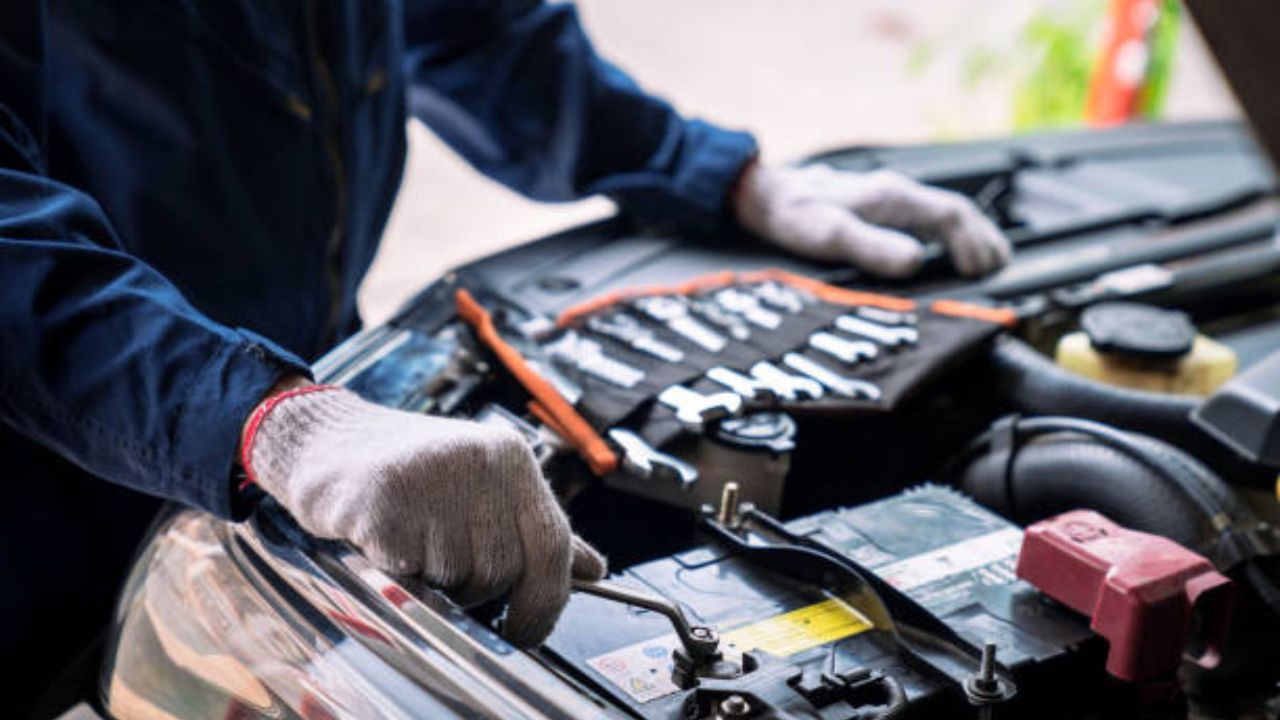First, ensure safety by wearing protective gloves and goggles to clean a car battery. Then, disconnect the battery terminals, mix baking soda and water to create a cleaning solution, use a toothbrush to scrub the terminals, rinse with water, and reconnect the terminals securely.
Taking care of your car’s battery is essential for its longevity and performance. Over time, battery terminals can become corroded or dirty, leading to weak electrical connections and potential starting problems. Regularly cleaning your car battery can help prevent these issues and ensure smooth operation.
This guide will provide step-by-step instructions on cleaning a car battery effectively. With simple tools and basic safety precautions, you can easily keep your car’s battery in optimal condition and extend its lifespan. Let’s get started with the cleaning process.
Importance Of Cleaning Car Battery
Regularly cleaning the car battery is essential for maintaining its performance and longevity. Accumulated dirt and corrosion can lead to poor conductivity and power issues. Using a mixture of baking soda and water to clean the terminals gently can help ensure optimal battery functionality.
Ensuring Proper Functioning
Regularly cleaning a car battery is crucial to ensure its proper functioning. A dirty battery can hinder your vehicle’s performance and potentially lead to problems starting your car.
By cleaning the battery regularly, you can prevent the build-up of dirt, debris, and corrosion that may affect its ability to provide a consistent power supply.
A clean battery also allows for better electrical connections, reducing the chances of power loss or voltage drops. Ensuring your car battery is clean will help maintain its efficiency and prolong its lifespan.
Preventing Corrosion
Cleaning your car battery is vital in preventing corrosion. Over time, dirt, grime, and chemicals can accumulate on the battery terminals and connectors, leading to corrosion. Corroded battery terminals can cause poor electrical connections, resulting in voltage irregularities or even complete failure of your car’s electrical system.
Regularly cleaning the battery can remove any existing corrosion and prevent further damage. After cleaning, applying a protective coating, such as petroleum jelly, can help prevent future corrosion, ensuring optimal battery performance.

Necessary Tools And Materials
When cleaning a car battery, having the necessary tools and materials is essential. Not only does this make the process more efficient, but it also ensures that you can safely and effectively clean the battery. This section will explain what you’ll need to clean your car battery.
Safety Gear
Before you begin the cleaning process, it’s crucial to prioritize your safety. Wearing the proper safety gear is essential to protect yourself from any potential hazards. Here are the safety gear items you should have:
- Safety goggles: Protect your eyes from any splashes or chemical residue that may come in contact with them.
- Rubber gloves: Shield your hands from the cleaning agents and prevent direct contact with the battery.
- Long-sleeved clothing: Cover your arms to minimize the risk of skin exposure to the battery or cleaning agents.
Cleaning Agents
You’ll need suitable cleaning agents to clean your car battery effectively. These cleaning agents remove dirt, corrosion, and buildup from the battery terminals. Here are the recommended cleaning agents:
- Baking soda: A natural and effective cleaning agent that helps neutralize the acid and remove corrosion.
- Water: Use clean water to rinse off the battery terminals after cleaning.
- Wire brush: An abrasive brush that helps scrub off any stubborn corrosion or buildup on the battery terminals.
| Safety Gear | |
|---|---|
| Safety goggles | Protect your eyes from splashes or chemical residue |
| Rubber gloves | Shield your hands from cleaning agents and battery contact |
| Long-sleeved clothing | Minimize skin exposure to battery or cleaning agents |
| Cleaning Agents | |
|---|---|
| Baking soda | Neutralizes acid and removes corrosion |
| Water | Used for rinsing off the battery terminals |
| Wire brush | It helps scrub off stubborn corrosion or buildup |
Step-by-step Cleaning Process
Cleaning your car battery is essential to maintain its performance and longevity. Follow these simple steps to ensure a thorough cleaning process.
Preparing The Area
Before cleaning, prepare the area by gathering the necessary supplies, including baking soda, water, a wire brush, protective gloves, and safety goggles. Ensure the car is parked in a well-ventilated area and the engine is turned off.
Removing Corrosion
- 1. Wear gloves and goggles to protect your skin and eyes from the acidic corrosion.
- 2. Mix a tablespoon of baking soda with a cup of water to create a cleaning solution.
- 3. Carefully remove the battery terminals using a wrench, starting with the negative terminal followed by the positive terminal.
- 4. Scrub the terminals and battery posts with the wire brush and baking soda solution to remove the corrosion buildup.
- 5. Rinse the area with clean water to neutralize the acid and prevent further corrosion.
Cleaning The Terminals
- 1. Inspect the terminals and cables for any signs of damage or wear. Replace any corroded or damaged components.
- 2. Apply a thin layer of petroleum jelly to the battery terminals to prevent future corrosion.
- 3. Reattach the battery terminals in reverse order, starting with the positive and negative terminals.
Rinsing And Drying
After cleaning and reattaching the terminals, thoroughly rinse the area with clean water to remove any baking soda residue. Allow the battery and terminals to air dry completely before starting the engine. This will help prevent any potential electrical hazards and ensure a secure connection.

Additional Maintenance Tips
Once you’ve cleaned your car battery, additional maintenance tips can help extend its lifespan and ensure optimal performance. These tips include using terminal protectors and regularly inspecting the battery for any signs of damage or corrosion.
Using Terminal Protectors
Terminal protectors are small plastic caps that fit over the battery terminals. They act as a barrier between the terminals and the surrounding environment, preventing dirt, moisture, and corrosion buildup. Terminal protectors can significantly reduce the risk of your battery terminals getting damaged or corrupted, extending your lifespan.
Regular Inspections
Regular inspections of your car’s battery are crucial to catch any potential issues before they escalate into major problems. Inspect the battery regularly, paying close attention to any signs of damage, such as cracks in the casing or loose terminals.
Additionally, watch for corrosion on the terminals, which can hinder the battery’s performance. If you notice any of these issues during your inspection, you must take immediate action to address them.
Here’s a simple checklist to follow during your regular battery inspections:
- Inspect the battery casing visually: Look for cracks, bulges, or leaks. If you notice any damage, it may be a sign of an internal problem, and it’s best to have the battery checked by a professional.
- Check the battery terminals: Ensure that the terminals are tight and secure. Loose terminals can lead to poor electrical connections and diminished battery performance.
- Look for corrosion: Examine the battery terminals for any signs of corrosion indicated by a powdery substance or greenish-blue deposits. If you notice corrosion, cleaning it off immediately using a mixture of baking soda and water is crucial.
- Inspect the battery cables: Check the cables for any fraying, cracks, or signs of wear. Damaged cables can lead to electrical issues, so having them repaired or replaced is essential.
- Keep the battery clean: Regularly clean the surface of the battery using a rag or brush to remove any dirt, grime, or debris.
By following these additional maintenance tips in conjunction with the proper cleaning techniques, you can prolong the life of your car battery and ensure that it remains in optimal condition for years to come.
Conclusion And Performance Impact
Regularly cleaning your car battery can significantly impact its performance, ensuring optimal functionality and longevity. By following the proper cleaning procedures, you can keep your car battery in top shape, minimizing the risk of issues and maximizing its efficiency.
Benefit Of Well-maintained Battery
Maintaining your car battery is crucial for optimal performance and longevity. By taking proper care of your car battery, you can ensure that it performs at its best and serves you for a more extended period.
Ensuring Longevity
A well-maintained car battery offers several benefits to your vehicle. In addition to improving performance, it also helps ensure the battery’s longevity, protecting you from frequent replacements and unexpected breakdowns.
- Regularly cleaning the battery terminals and removing any corrosion or buildup can prevent potential electrical problems and extend the battery’s lifespan.
- By keeping the connectors and cables free from dirt and debris, you can prevent loss of power and maintain a consistent flow of electricity to your vehicle’s electrical systems.
- Properly securing the battery can reduce the risk of vibrations and shocks, damaging the battery’s internal components and leading to premature failure.
You can increase your car battery’s overall performance and longevity by following simple maintenance steps. Smoothening the functioning of your vehicle also helps you avoid inconveniences that can hamper your daily routine.
| Benefits of Well-Maintained Car Battery | Performance Impact |
|---|---|
|
|
Keeping your car battery clean and well-maintained has multiple benefits for your vehicle’s performance and longevity. Regular maintenance enhances the safety of your electrical systems and helps avoid costly battery replacements.
By implementing simple cleaning and maintenance routines, you can ensure that your car battery remains in optimal condition, allowing you to enjoy a reliable and smooth driving experience.

Clean car battery corrosion without removing
Cleaning car battery corrosion without removing the battery can be done cautiously. Here’s a step-by-step guide:
Materials you’ll need:
- Baking soda
- Water
- A stiff brush (an old toothbrush or a wire brush can work)
- Safety gear (gloves and safety glasses)
Steps:
- Safety First:
- Before you begin, wear safety gear, especially gloves and safety glasses, to protect your hands and eyes from potential contact with battery acid.
- Inspect the Battery:
- Visually inspect the battery for any cracks or damage. If you notice any severe damage, it’s crucial to address it appropriately and consider seeking professional assistance.
- Mix Baking Soda Solution:
- In a container, mix a solution of baking soda and water. A couple of tablespoons of baking soda in a cup of water should be sufficient.
- Apply the Solution:
- Use the brush to apply the baking soda solution to the corroded areas on the battery terminals. Make sure the solution reaches all the corroded parts.
- Scrub Gently:
- Gently scrub the corroded areas with the brush. Do not create excessive dust or let the solution drip into the battery’s cells.
- Wipe Away Residue:
- Use a clean, damp cloth or sponge to remove the baking soda solution and any residue. Ensure the area around the battery is also cleaned to prevent further corrosion.
- Inspect and Dry:
- Inspect the terminals to ensure that corrosion has been removed. Allow the terminals to air dry completely.
- Prevent Future Corrosion:
- Consider applying a thin coat of petroleum jelly or a commercial battery terminal protector to the clean terminals. This helps prevent future corrosion.
- Check for Loose Terminals:
- While you’re at it, check if the terminals are tight. If they are loose, tighten them appropriately.
- Monitor Battery Health:
- Keep an eye on your battery’s health and charge regularly. If you notice any issues, it’s advisable to consult a professional.
Remember, if you’re uncomfortable or unsure about cleaning the battery, it’s always a good idea to seek assistance from a professional mechanic or technician. Safety is the top priority when dealing with car batteries.
How to clean car battery corrosion
Cleaning car battery corrosion is essential for maintaining a good electrical connection and preventing damage to your vehicle. Here’s a step-by-step guide on how to clean car battery corrosion:
Materials you’ll need:
- Baking soda
- Water
- Disposable gloves
- An old toothbrush or battery terminal brush
- Adjustable wrench or pliers
- Corrosion preventative spray or petroleum jelly (optional)
Steps:
- Safety First: Ensure your vehicle is turned off and the keys are out of the ignition. Also, wear protective gloves to prevent any skin irritation.
- Disconnect the Battery: Use an adjustable wrench or pliers to loosen and remove the negative (-) cable first, followed by the positive (+) cable. Always disconnect the negative terminal first to minimize the risk of a short circuit.
- Remove the Battery: Remove the battery from the vehicle for better access.
- Mix Baking Soda Solution: Mix a couple of tablespoons of baking soda with water in a small container to form a paste. Baking soda is mildly alkaline and helps neutralize the acid in the corrosion.
- Apply baking: soda paste to the corroded areas on the battery terminals and cable connectors using an old toothbrush or battery terminal brush to apply the baking soda paste. Scrub gently to break down the corrosion.
- Rinse with Water: Use a damp cloth or sponge to wipe away the baking soda paste. If you removed the battery, rinse it with water. Make sure not to get water into the battery cells.
- Dry Thoroughly: Allow the battery and terminals to dry entirely before reconnecting. You can use a clean, dry cloth to speed up the process.
- Reconnect the Battery: Reconnect the positive (+) cable first, followed by the negative (-) cable. Make sure the connections are tight.
- Optional: Apply Corrosion Preventative: To help prevent future corrosion, you can apply a thin layer of corrosion preventative spray or petroleum jelly to the cleaned terminals.
- Check for Tightness: Ensure that all connections are tight and secure.
By following these steps, you can effectively clean car battery corrosion and help maintain a reliable electrical system in your vehicle. Regular maintenance of your battery terminals can contribute to a longer battery life and reduce the risk of electrical issues.
Frequently Asked Questions For How To Clean A Car Battery
How Often Should I Clean My Car Battery?
It is recommended to clean your car battery at least once a year. However, if you live in an area with extreme weather conditions or notice signs of corrosion, it is advisable to clean it more frequently.
What Are The Signs Of A Dirty Car Battery?
The signs of a dirty car battery include corrosion around the terminals, a poor connection that affects the vehicle’s electrical system, and difficulty starting the car. If you notice any of these signs, cleaning the battery as soon as possible is crucial.
What Supplies Do I Need To Clean A Car Battery?
To clean a car battery, you will need a wire brush or battery terminal cleaner, a mixture of baking soda and water, safety goggles and gloves, and a wrench or pliers to remove the battery cables.
Can I Clean A Car Battery Without Removing It?
Following proper safety precautions, you can clean a car battery without removing it. However, disconnect the battery cables before cleaning to avoid any electrical accidents or damage to the vehicle’s electrical system.
What is the best thing to use to clean a car battery?
Mixing baking soda and water is an effective solution for cleaning a car battery. This mixture helps neutralize acid residue and corrosion on the battery terminals. After cleaning, rinse thoroughly with water and dry the battery terminals to prevent further corrosion. Additionally, applying a small amount of petroleum jelly or terminal grease after cleaning can help protect the terminals from future corrosion.
Is it OK to wash the car battery?
It is generally not recommended to wash a car battery with water. Water can cause damage to the battery and its components. If there is dirt or corrosion on the battery terminals, a better approach is to use baking soda and water to clean them. However, disconnecting the battery terminals before cleaning is crucial; rinse thoroughly with water and dry the terminals to prevent any residue. Washing the entire battery with water is not advisable, as it may lead to electrical issues or damage to the battery. Always exercise caution and follow safety guidelines when working with car batteries.
Can you clean the inside of a car battery?
No, it would be best not to attempt to clean the inside of a car battery. The inside of a car battery contains sulfuric acid and attempting to open or clean it can be dangerous and may damage the battery. If there are issues with the battery, it’s advisable to seek professional assistance or replace the battery if necessary.
How much baking soda do I use to clean my car battery?
To clean a car battery with baking soda, you can make a cleaning solution by mixing 1 to 2 tablespoons of baking soda with a cup of water. Stir the mixture until the baking soda is dissolved. This solution is then used to clean the battery terminals and nearby areas affected by corrosion. After applying the solution, rinse the battery terminals with water and thoroughly dry them to prevent residual moisture. Always wear appropriate protective gear, such as gloves and eye protection, when working with car batteries and cleaning solutions.
What household items can you use to clean a car battery?
You can use household items like baking soda, water, and a wire brush to clean a car battery. Mix a tablespoon or two of baking soda with a cup of water to create a cleaning solution. Use a wire brush to scrub the battery terminals and nearby areas affected by corrosion. Always wear protective gear, such as gloves and eye protection, when working with car batteries and cleaning solutions.
What is the fastest way to clean car battery terminals?
The fastest way to clean car battery terminals is by using a mixture of baking soda and water and a wire brush for scrubbing.
Is vinegar good for a battery?
No, vinegar is not recommended for cleaning car batteries. It can damage the battery and is not practical in neutralizing battery acid. Use a baking soda and water solution instead.
Conclusion
Regular car battery maintenance is essential for optimal performance. By following the simple steps outlined in this guide, you can ensure the longevity of your battery and avoid unexpected breakdowns. With proper cleaning and inspection, your car battery will continue to provide reliable power for your vehicle.
Take care of your battery, and it will take care of you.

I am a Mahdi . I have four two of experience in Technology and all types of Battery’s like Solar Battery, Car Battery, Lithium Battery etc. So I work on solving these issues and give various tips on these issues.
